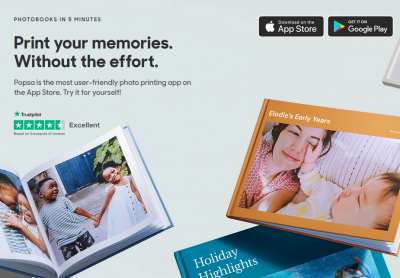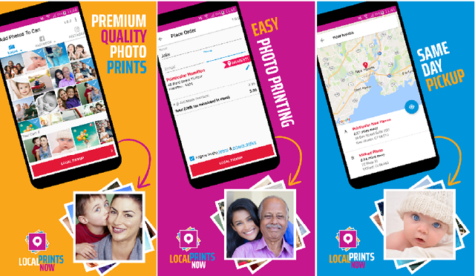UK-based Futuresource Consulting has tipped that ‘vertically integrated’ photo print services businesses could be subject to a ‘paradigm shift’, with simple app-based alternatives the disruptive new kid on the block.

‘At a time when newer, app-based resellers continue to grow in the Photo Output markets in Western Europe, this begs the question: “Are we seeing a paradigm shift in the Photo Output sector?”’
We asked Futuresource analyst Jeremy Wills, who authored the marker research consultant’s 2021 Photo Output reports how he defined ‘vertical integration’ in photo printing services: ‘I mean Web-to-Home companies that both print (in house) and sell, with one (or more) consumer facing websites, such as Shutterfly in the USA, and here in Europe, The Photobox Group, Albelli, Ifolor, Smartphoto, etc.’
Futuresource in not saying the big photo services businesses’ days are necessarily over, but rather they are likely to simplify their business model: ‘de-integrate’, so to speak.
Futuresource points to the recent sale of The Photo Box Group’s UK printing plant to The Precision Proco Group – think Vistaprint – as an indication large photo print service providors are in decline. It further points to the January 2021 float of former subsidiary Moonpig/Greetz (mainly cards and gifting) as another indication the days of the all-singing, all-dancing ‘vertically integrated’ photo printing conglomerates are numbered.
However, Precision Proco Group will continue to print Photo Box orders at its former facility – it could be seen as simply an outsourcing decision, and Futuresource says as much later in its article: ‘…The lens now turns to the vertically-integrated players, who have manufacturing and front-end cost bases. Will we start to see more activity such as The Photobox Group’s sale of its UK plant? This is quite likely, as it would allow these successful printer-resellers to focus on the front-end.’
‘In the early 2000’s, we saw the rise of vertically integrated Photo companies, with in-house printing and one or more front-end website(s) riding the dot.com wave as e-commerce proliferated, especially in northwest Europe and the Nordics,’ wrote Jeremy.
‘Over recent years, these vertically integrated players have consolidated, with The Photobox Group, Albelli and Picanova in particular acquiring strategic competitors.’
Futuresource argues that the trend of the big players stepping away from the ‘manufacturing’ (printing) and focusing on online marketing, is being driven by ‘the rise of “fleet of foot”, front-end, AI focussed Photo apps, with low overheads (all printing outsourced and, often, an intermediary between them and the white label Print Service Provider to avoid the cost of in-house production staff.’
New players?
While the new apps generate work for existing photo stores, ‘they are also generating work for PSPs that have not been Photo category players, but that have the equipment and capability to print and distribute personalised Photo products.’
The Photo apps are not necessarily offering the depth of SKUs that larger, established photo resellers do; however their strength is actually in this limited catalogue, the related simplicity of use and commensurate, lower cost base.
‘It is not all bad news for the more incumbent online Photo resellers, as some of the newer apps, especially for photobooks seem to have created a new stratum in the market – small, easy to order photobooks – that is not entirely cannibalising the core of the photobook sector: the 26-page plus A4 photobook.

‘We have also seen the impact of these apps on the photo prints sector, particularly on-site photo printing, both minilabs and instant print kiosks. The popularity of instant print cameras in the last decade has brought some digital natives to retail photo printing. However, when they realise that they can order (often silver halide) photo prints for as little as 10 Euro cents, including delivery charges, from an app or website, they do not all return to retail. This pattern has been exacerbated by the COVID pandemic events of the last 17 months.’
Futuresource’s 2021 Photo Output reports (Photobooks, Photo-Merchandise and Photo Prints) covering the top-6 markets in Western Europe drill down on the recent performance and future outlook for the Photo Output sector in these changing times, with the Western Europe top-6 markets’ combined Photo Output value set to rise by 16 percent from 2019 to 2025, hitting €3.6 billion by 2025.
Now read: https://www.insideimaging.com.au/2021/photo-printing-on-autopilot/
The last six to seven years have seen the rise of “fleet of foot”, front-end, AI focussed Photo apps, with low overheads (all printing outsourced and, often, an intermediary between them and the white label Print Service Provider (PSP) to avoid the cost of in-house production staff).
These apps play into the hands of the existing white label Photo PSPs but are also generating work for PSPs that have not been Photo category players, but that have the equipment and capability to print and distribute personalised Photo products.
The Photo apps are not necessarily offering the depth of SKUs that larger, established Photo resellers do; however their strength is this limited catalogue and commensurate, lower cost base.
It is not all bad news for the more incumbent online Photo resellers, as some of the newer apps, especially for photobooks seem to have created a new stratum in the market – small, easy to order photobooks – that is not entirely cannibalising the core of the photobook sector: the 26-page plus A4 photobook.
We have also seen the impact of these apps on the photo prints sector, particularly on-site photo printing, both minilabs and instant print kiosks. The popularity of instant print cameras in the last decade has brought some digital natives to retail photo printing. However, when they realise that they can order (often silver halide) photo prints for as little as 10 Euro cents, including delivery charges, from an app or website, they do not all return to retail. This pattern has been exacerbated by the COVID pandemic events of the last 17 months.
With more Photo orders therefore churning through existing white label Photo PSPs, the lens now turns to the vertically integrated players, who have manufacturing and front-end cost bases. Will we start to see more activity such as The Photobox Group’s sale of its UK plant? This is quite likely, as it would allow these successful printer-resellers to focus on the front-end. (There is always the caveat that when one is a customer to a white label PSP, in peak times, there are multiple orders from multiple customers for that PSP to service and, if needs be, to prioritise).





Be First to Comment